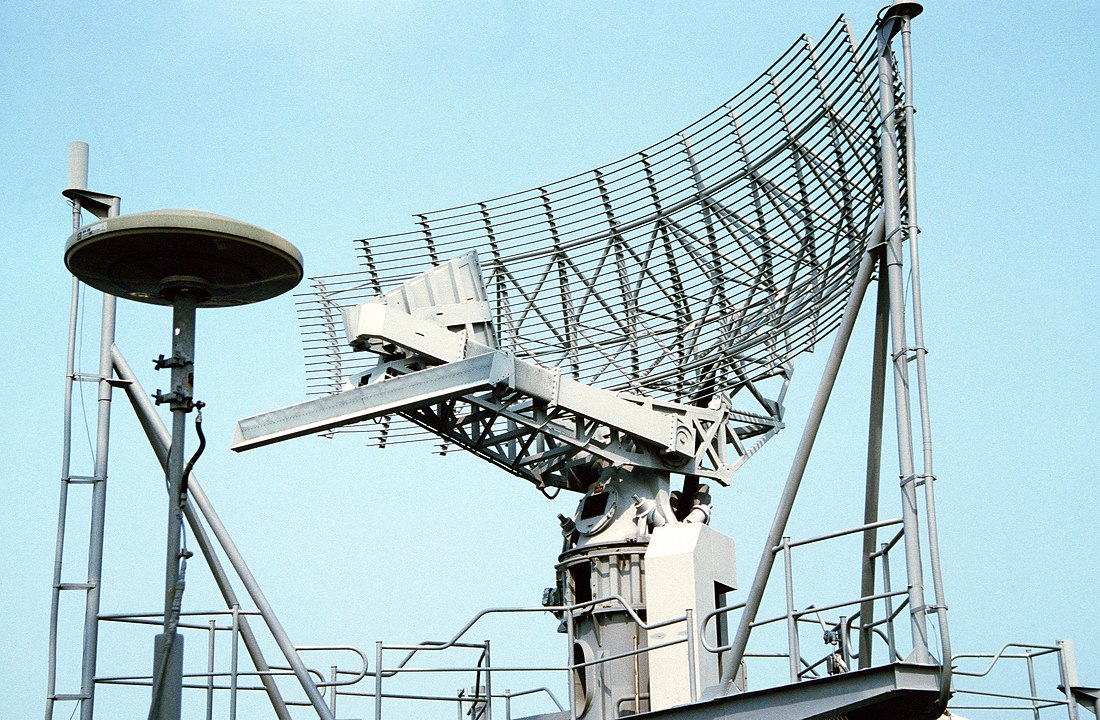Top Qs
Timeline
Chat
Perspective
AN/SPS-49
2-D long-range air search radar of the United States Navy From Wikipedia, the free encyclopedia
Remove ads
The AN/SPS-49 is a United States Navy two-dimensional, long range air search radar built by Raytheon that can provide contact bearing and range. It is a primary air-search radar for numerous ships in the U.S. fleet and in Spain, Poland, Taiwan aboard Oliver Hazard Perry-class frigates, Canada on its Halifax-class frigate (prior to FELEX mid-life upgrade) and New Zealand on its Anzac-class frigates. It formerly served in a complementary role aboard Aegis cruisers with the AN/SPY-1 but the systems are currently being removed during routine upgrade with no replacement.
In accordance with the Joint Electronics Type Designation System (JETDS), the "AN/SPS-49" designation represents the 49th design of an Army-Navy electronic device for surface ship search radar system. The JETDS system also now is used to name all Department of Defense electronic systems.
Remove ads
Operation
Summarize
Perspective
First tested in 1965 aboard USS Gyatt and introduced in 1975, the AN/SPS-49 operates in the 851–942 MHz, or L-, band and has a range of 256 nautical miles (474 km). The orange-peel parabolic shape of the antenna creates a narrow 3.3°-beam to reduce the probability of detection or jamming. It can rotate at 6 rpm in long range mode or 12 rpm in short-range mode.[1] Default is at 12 rpm for the AN/SPS-49A(V)1, to provide more frequent scans against incoming missiles. The SPS-49A(V)1 can detect out to its full range at either 6 or 12 rpm. The antenna is stabilised to compensate for ships pitch and roll, to a maximum of +/-15° for both pitch and roll in 12 rpm mode, and +/-23.5° for both pitch and roll in 6 rpm mode. The output stage of the transmitter in all variants uses a two-cavity klystron amplifier.

In 1998, the Inspector General of the Department of Defense reported that SPS-40 and SPS-49 radars in Bahrain were "unusable because the equipment operates on a frequency that interferes with the Bahrain telecommunications services".[2]
On board ships
 United States
United States
 Republic of China
Republic of China
 Italy
Italy
 Australia
Australia
 Canada
Canada
 New Zealand
New Zealand
- Te Kaha-class frigate (Replaced with SMART-S as part of the FSU programme in the early 2020s)

 South Korea
South Korea
Remove ads
Variants
As of 2014, there are eleven configurations of the AN/SPS-49(V).
- AN/SPS-49(V)1: Baseline radar (Various CVN, LHA, LSD and other ships)
- AN/SPS-49(V)2: (V)1 radar without the coherent side lobe cancellation feature (Oliver Hazard Perry-class frigates)
- AN/SPS-49(V)3: (V)1 radar with the radar video processor (RVP) interface (FC-1) (USS Long Beach)
- AN/SPS-49(V)4: (V)2 with the RVP interface (Oliver Hazard Perry-class frigates)
- AN/SPS-49(V)5: (V)1 with automatic target detection (ATD) (New Threat Upgrade (NTU) ships)
- AN/SPS-49(V)6: (V)3 system with double shielded cables and a modified cooling system (USS Ticonderoga)
- AN/SPS-49(V)7: (V)5 system with a (V)6 cooling system (Aegis combat system)
- AN/SPS-49(V)8: (V)5 system enhanced to include the AEGIS Tracker modification kit (Aegis combat system)
- AN/SPS-49(V)8 ANZ: (V)8 system modified to interface with the CelsiusTech 9LV-453 combat system (Anzac-class frigates)
- AN/SPS-49(V)9: (V)5 with medium PRF upgrade (MPU)
- AN/SPS-49A(V)1: Developed in the mid-1990s. Added radial speed determination on each target, each scan. Improved clutter rejection
Remove ads
See also
References
External links
Wikiwand - on
Seamless Wikipedia browsing. On steroids.
Remove ads

